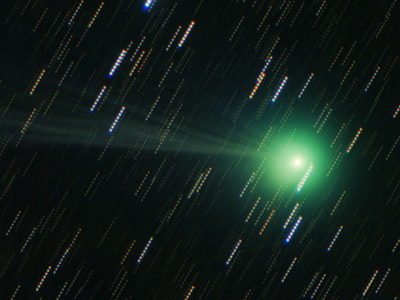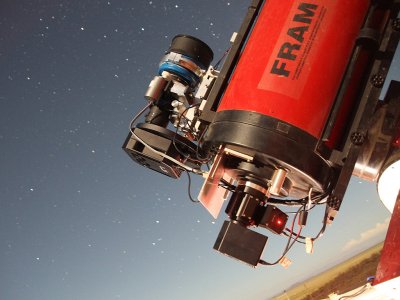|
The FRAM robotic telescope is operated by the Institute of Physics of
the Czech Academy of
Sciences. Its primary purpose is to monitor atmospheric
extinction to support high-energy particle showers observation by the
Pierre Auger observatory Cherenkov telescope array. However, the
telescope is also used for other research programs, like variable star
observation, exoplanet transit measurements and also for photometry
and astrometry of asteroids and comets.

Image of comet Lovejoy, acquired by FRAM telescope
wide-field camera through photometric BVR filters The main advantage of the FRAM telescope for observers from Europe
is its location on the southern hemisphere. It can observe parts of
the sky, which are not accessible from northern latitudes.

FRAM robotic telescope with G2-1600 camera on the main
0.3 m telescope and
G4-16000 camera on the 300 mm Nikkor
lens FRAM main optical tube assembly is 12 inch (305 mm)
Schmidt-Cassegrain telescope on Paramount ME mount, with G2-1600 CCD camera. There is also 300 mm focal length, f/2.8
photographic lens (107 mm diameter) for
wide field imaging using large format G4-16000 CCD camera, piggybacked on the main OTA.
Both instruments are equipped with filter wheel and UBVRI photometric
filters. The whole setup is controlled by RTS2 software package.
FRAM is not the only telescope equipped with Gx CCD cameras,
supporting observations on the Pierre Auger Observatory. Also all-sky
cameras, monitoring entire sky when the Cherenkov telescopes are
observing, developed by Research Center for Optics of Palacky University
Olomouc, use G1 cameras as a base of the system.
Image of comet Lovejoy: Martin Masek/FRAM/Institute of Physics,
Czech Academy of Sciences.
| 